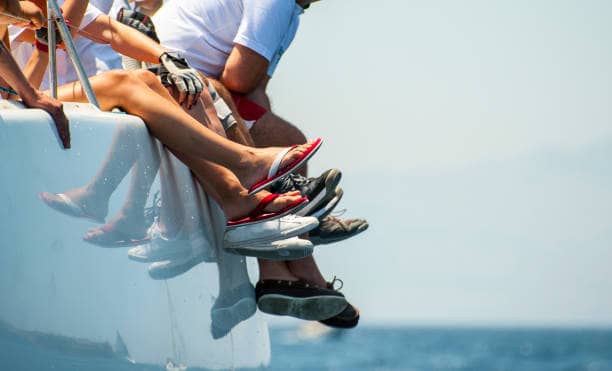Have you ever wondered why some people say you can’t wear shoes on a yacht? This practice, although not universal, raises the question: Why can’t you wear shoes on a yacht?
Well, there’s a reason behind it! The reason is to preserve the yacht’s opulence, ensure safety, and foster a relaxed environment.
In simple terms, it’s like having a rule at a friend’s house – you take off your shoes to keep everything clean and nice. Let’s find out why this rule exists and what makes it important!
Why Can’t You Wear Shoes On A Yacht

The main reason you can’t wear your shoes on a yacht is to prevent dirt, sand, or other debris from being tracked onto the vessel’s interior, where it can damage the flooring and furnishings or contribute to overall wear and tear.
Yachts often have luxurious interiors with expensive materials, and maintaining a clean and well-kept environment is a priority for owners and operators.
As a result, guests may be asked to remove their shoes and, in some cases, wear specific types of soft-soled or non-marking shoes while on board.
In a more elaborate term, here are several reasons why some people on yachts might choose to go barefoot:
Deck Protection
Yachts often have teak or other sensitive decking materials. Going barefoot can help prevent damage to the decks, as shoes may scuff or mark the surfaces.
Comfort
Being barefoot can be more comfortable, especially in a leisurely and relaxed setting like a yacht. It’s a way to embrace a casual and laid-back atmosphere.
Cleanliness
Yacht interiors are typically well-maintained and clean. Going without shoes can help keep the interior spaces free from dirt, sand, and debris that might be glued to the soles of shoes.
Customary Practice
On some yachts, especially those in warmer climates, going barefoot might be a customary practice. It can contribute to a more relaxed and informal atmosphere.
Safety
Wearing shoes with hard soles may pose a slipping hazard on wet or polished surfaces. Going barefoot or wearing soft-soled shoes can reduce the risk of accidents.
Can You Wear High Heels on a Yacht?
No, high heels are mostly not allowed on the yacht. Yachts often have delicate or easily damaged deck surfaces, and high heels with sharp or narrow points can cause damage to the decking material.
Also, high heels pose a safety risk, especially on a moving vessel or in areas with wet or slippery surfaces. The risk of slipping and injury may increase when wearing high heels.
You should understand that yachting is often associated with a more casual and relaxed atmosphere, and wearing high heels may be considered impractical or out of place in such environments.
Can You Wear Slides on a Yacht?
Yes, wearing slides on a yacht is generally acceptable, and they are often a practical and comfortable choice for a maritime setting. Slides are open-toed sandals with a backless design, usually characterized by a single strap that goes across the foot.
They are easy to slip on and off, making them convenient for casual and relaxed environments like a yacht.
What are Yacht Shoes Called?
The type of shoes commonly worn on yachts are called “boat shoes” or “deck shoes.” These shoes are specifically designed for boats and yachts offering features that make them well-suited for the maritime environment.
These shoes usually have non-marking rubber soles to prevent scuffing and marking on the boat’s deck. They often have a slip-resistant or sipped sole design to provide traction on wet surfaces.
They have a functional lacing design that allows for a snug fit. In addition, they often have cushioned insoles and are made of material that easily dry
Can You Wear Flip Flops on a Yacht?
Yes, you can wear flip-flops on a yacht. Flip flops are easy to slip on and off, making them convenient for activities on and off the yacht. However, it’s important to consider these few things when wearing a flip-flop on a yacht. They include:
Deck Surface
Check the type of deck surface on the yacht. Some yacht owners or operators may prefer guests to wear footwear that is gentle on the deck to avoid scratches or damage.
Safety
Be mindful of the potential slip hazards on a yacht, especially when surfaces are wet. Some flip-flops do not provide as much traction as other shoes, so it’s important to prioritise safety.
Formality
The appropriateness of flip flops depends on the occasion formality or the specific rules of the yacht. In more formal settings or certain events, it might be more appropriate to go for other types.
Are there any Specific Shoe Requirements for Luxury Yachts?
Yes, luxury yachts often have specific shoe requirements to ensure the preservation of the vessel and maintain a high standard of cleanliness.
Many luxury yachts request or require guests to remove their shoes when entering the interior spaces. This helps to keep the yacht’s pristine and often expensive interior in top condition.
However, some luxury yachts can allow specific boats or soft-soled shoes. It is advised to communicate with the yacht management when boarding, as this will guide your choices.
Best Shoes to Wear on a Yacht
The best shoes to wear on a yacht depend on the specific circumstances, the yacht owner’s preferences, and the activities you plan to engage in. Here are some types of shoes that are generally considered suitable for yachting:
- Boat Shoes (Deck Shoes): These shoes are designed specifically for boating and yachting. They typically have non-marking rubber soles, are comfortable, and provide good traction on wet surfaces.
- Slip-On Shoes: Slip-on shoes, like loafers or casual slip-ons, can be convenient for quickly getting on and off the yacht. Look for styles with non-marking soles.
- Espadrilles: Lightweight and comfortable, espadrilles are a good choice for casual yachting activities. They are easy to slip on and off and are often made with soft soles.
- Canvas Sneakers: Low-profile canvas sneakers with non-marking soles are suitable for a casual and comfortable yachting experience. They are lightweight and versatile.
- Deck Sandals: Sandals designed for boating or water activities can be appropriate if you prefer an open-toe option. Look for sandals with non-slip soles.
- Water Shoes: If you plan to engage in water activities or use water toys, water shoes can protect your feet while ensuring good traction.
When choosing shoes for a yacht, keep the following factors in mind:
- Non-Marking Soles: Choose shoes with non-marking soles to protect the yacht’s surfaces.
- Comfort: Yachting often involves spending extended periods on your feet, so prioritize comfortable shoes.
- Versatility: Consider the shoe’s versatility for different settings, both on deck and, if applicable, onshore.
Yacht Shoe Etiquette: Do’s and Don’ts
Yacht shoe etiquette can vary based on the specific rules set by the yacht owner, captain, or crew, as well as the formality of the setting. Here are some general do’s and don’ts to keep in mind when it comes to footwear on a yacht:
Do’s:
- Check the Rules: Always inquire about the yacht’s specific rules and preferences regarding footwear. This can include whether shoes are allowed on board, if certain types are preferred, or if guests go barefoot.
- Boat Shoes: Boat shoes or deck shoes are generally a safe and appropriate choice for yachting. They are designed for the marine environment, featuring non-marking soles and good traction.
- Comfortable and Practical: Choose comfortable and practical footwear, especially if you anticipate walking on different surfaces. Yachting often involves both deck activities and onshore excursions.
- Non-Marking Soles: If wearing shoes, ensure they have non-marking soles to avoid scuffing or damaging the yacht’s surfaces.
- Respect the Interior: If shoes are allowed in certain interior spaces, be mindful of cleanliness. Wipe your shoes if necessary to avoid bringing in dirt or debris.
Don’ts:
- High Heels: Avoid wearing high heels unless it’s explicitly allowed. High heels can damage delicate yacht surfaces and pose safety risks.
- Dark-Soled Shoes: Dark-soled shoes can leave marks on the deck, so it’s generally a good idea to avoid them.
- Dirty Shoes: If you’ve been ashore and your shoes are dirty, clean them or change into a more suitable pair before returning to the yacht.
- Non-Breathable Footwear: Yachting can involve exposure to the sun and warm weather. Avoid wearing non-breathable footwear that may cause discomfort.
- Unsuitable Footwear for Activities: If you plan to engage in specific activities like water sports, choose appropriate footwear. High-end fashion shoes may not be suitable for active pursuits.
- Wet Shoes Inside: If your shoes are wet, avoid walking on interior surfaces until they are dry to prevent slips and maintain cleanliness.
Always remember that yacht shoe etiquette can vary, so communication is vital.
When in doubt, ask the crew or follow the lead of others on board.
Conclusion
The no-shoes rule on a yacht is about keeping things tidy and safe. Yachts have beautiful floors inside and on the deck, and the rule helps protect them from scratches and dirt.
Plus, going barefoot or wearing special shoes makes it safer, especially when the boat is swaying or there’s water around.
Remember, it’s like a little tradition to ensure everyone enjoys their time on the yacht without any worries about mess or accidents.
It is advised you always check with the yacht owner, captain, or crew about any specific dress code or guidelines they may have for the particular yacht trip. This helps to guide your choice of footwear or whether it is not needed at all.
